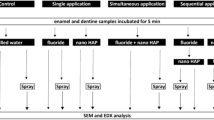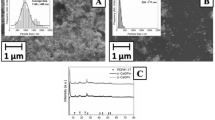Abstract
Objectives
The aim of this study was to assess the in vitro caries preventive effect of nanocomplexed solutions of hydroxypropyl-β-cyclodextrin and γ-cyclodextrin associated with titanium tetrafluoride (TiF4) after different complexation times (12 or 72 h).
Materials and methods
Enamel blocks were randomly distributed in 9 groups (n = 11): negative control, hydroxypropyl-β-cyclodextrin, γ-cyclodextrin, TiF4, hydroxypropyl-β-cyclodextrin:TiF4 12 h, hydroxypropyl-β-cyclodextrin:TiF4 72 h, γ-cyclodextrin:TiF4 12 h, γ-cyclodextrin:TiF4 72 h, and NaF (positive control). The solutions were applied for 1 min and the blocks were exposed to a biofilm model. Nanocompounds were characterized by differential scanning calorimetry and X-ray powder diffraction. The percentage of surface microhardness loss (%SML), mineral density changes (ΔZ), lesion depth, surface morphology (scanning electron microscopy—SEM), and chemical characterization (energy-dispersive spectroscopy—EDS) were assessed.
Results
No oxidation was observed, and the formation of the nanocomplexes was evidenced by changes in the melting point compared to pure cyclodextrins and the loss of crystallinity of the materials. Hydroxypropyl-β-cyclodextrin:TiF4 72 h resulted in lower %SML than negative control, hydroxypropyl-β-cyclodextrin, γ-cyclodextrin, and TiF4 (p < 0.05). NaF differed from all groups (p < 0.05), except for hydroxypropyl-β-cyclodextrin:TiF4 72 h (p = 0.83). ΔZ of hydroxypropyl-β-cyclodextrin:TiF4 72 h was higher than negative control, hydroxypropyl-β-cyclodextrin, γ-cyclodextrin, γ-cyclodextrin:TiF4 1 2 h, γ-cyclodextrin:TiF4 72 h, and NaF (p < 0.05) and similar to TiF4 and hydroxypropyl-β-cyclodextrin:TiF4 12 h (p > 0.05). SEM/EDS detected Ti in the blocks subjected to TiF4-products.
Conclusion
The hydroxypropyl-β-cyclodextrin:TiF4 72 h solution showed caries preventive effect on the surface and subsurface of the enamel.
Clinical relevance
A hydroxypropyl-β-cyclodextrin nanosystem, in association with TiF4 after 72 h of complexation, may be a promising agent for the prevention of enamel demineralization.








Similar content being viewed by others
References
Fejerskov O (2004) Changing paradigms in concepts on dental caries: consequences for oral health care. Caries Res 38:182–191
Kilian M, Chapple ILC, Hannig M, Marsh PD, Meuric V, Pedersen AM, Tonetti MS, Wade WG, Zaura E (2016) The oral microbiome – an update for oral healthcare professionals. Br Dent J 18:657–666
Cho I, Blaser MJ (2012) The human microbiome: at the interface of health and disease. Nat Rev Genet 13:260–270
Freire MCM, Corrêa-Faria P, Costa LR (2018) Effect of dental pain and caries on the quality of life of Brazilian preschool children. Rev Saude Publica 52:30
Leal SC, Bronkhorst EM, Fan M, Frencken JE (2012) Untreated cavitated dentine lesions: impact on children’s quality of life. Caries Res 46:102–106
Ogaard B, Rolla G, Ruben J, Dijkman T, Arends J (1988) Microradiographic study of demineralization of shark enamel in a human caries model. Scand J Dent Res 96:209–211
ten Cate JM, Buzalaf MAR (2019) Fluoride mode of action: once there was an observant dentist. J Dent Res 98:725–730
Reed AJ, Bibby BG (1976) Preliminary report on effect of topical applications of titanium tetrafluoride on dental caries. J Dent Res 55:357–358
Büyükyilmaz T, Tangugsorn V, Ogaard B, Arends J, Ruben J, Rølla G (1994) The effect of titanium tetrafluoride (TiF4) application around orthodontics brackets. Am J Orthod Dentofac Orthop 105:293–296
Buslaev YA, Dyer DS, Ragsdale RO (1967) Hydrolysis of titanium tetrafluoride. Inorg Chem 6:2208–2212
Exterkate RA, ten Cate JM (2007) Effects of a new titanium fluoride derivative on enamel de- and remineralization. Eur J Oral Sci 115:143–147
Bowen WH (2016) Dental caries – not just holes in teeth! A perspective. Mol Oral Microbiol 31:228–233
Gould S, Scott RC (2005) 2-Hydroxypropyl-beta-cyclodextrin (HP-beta-CD): a toxicology review. Food Chem Toxicol 43:1451–1459
Loftsson T, Masson M (2001) Cyclodextrins in topical drug formulations: theory and practice. Int J Pharm 225:15–30
Yaksh TL, Jang JD, Nishiuchi Y, Braun KP, Ro SG, Goodman M (1991) The utility of 2-hydroxypropyl-beta-cyclodextrin as a vehicle for the intracerebral and intrathecal administration of drugs. Life Sci 48:623–633
Stella VJ, Rajewski RA (1997) Cyclodextrins: their future in drug formulation and delivery. Pharm Res 14:556–567
Szente L, Szejtli J, Kis GL (1998) Spontaneous opalescence of aqueous gamma-cyclodextrin solutions: complex formation or self-aggregation? J Pharm Sci 87:778–7781
Angelova A, Ringard-Lefebvre C, Baszkin A (1999) Drug-cyclodextrin association constants determined by surface tension and surface pressure measurements. II. Sequestration of water insoluble drugs from air–water interface: retinol-β-cyclodextrin system. J Colloid Interface Sci 212:280–285
Schönbeck C, Madsen TL, Peters GH, Holm R, Loftsson T (2017) Soluble 1:1 complexes and insoluble 3:2 complexes – understanding the phase-solubility diagram of hydrocortisone and γ-cyclodextrin. Int J Pharm 531:504–511
Kettel MJ, Dierkes F, Schaefer K, Moeller M, Pich A (2011) Aqueous nanogels modified with cyclodextrin. Polymer 52:1917–1924
Inoue Y, Shinohara I, Murata I, Kanamoto I (2019) Study on the molecular stability, solubility, and diffusibility of guaiazulene included in β- and γ-cyclodextrin. J Mol Struct 1186:50–59
Prochowicz D, Kornowicz A, Justyniak I, Lewiński J (2016) Metal complexes based on native cyclodextrins: synthesis and structural diversity. Coord Chem Rev 306:331–345
Nassur C, Alexandria AK, Pomarico L, Sousa VP, Cabral LM, Maia LC (2013) Characterization of a new TiF(4) and beta-cyclodextrin inclusion complex and its in vitro evaluation on inhibiting enamel demineralization. Arch Oral Biol 58:239–247
Vieira TI, Nassur C, Alexandria AK, Pomarico L, Sousa VP, Cabral LM, Valença AMG, Maia LC (2017) Effect of the inclusion nanocomplex formed of titanium tetrafluoride and β-cyclodextrin on enamel remineralization. J Pharm Bioallied Sci 9:201–207
Vieira TI, Câmara JVF, Cardoso JG, Alexandria AK, Pintor AVB, Villaça JC, Cabral LM, Romanos MTV, Fonseca-Gonçalves A, Valença AMG, Maia LC (2018) Cytotoxicity of novel fluoride solutions and their influence on mineral loss from enamel exposed to a Streptococcus mutans biofilm. Arch Oral Biol 91:57–62
Conde NC, Rebelo MA, Cury JA (2003) Evaluation of the fluoride stability of dentifrices sold in Manaus,AM, Brazil. Pesqui Odontol Bras 17:247–253
Schindelin J, Arganda-Carreras I, Frise E, Kaynig V, Longair M, Pietzsch T, Preibisch S, Rueden C, Saalfeld S, Schmid B, Tinevez JY, White DJ, Hartenstein V, Eliceiri K, Tomancak P, Fiji CA (2012) An open-source platform for biological-image analysis. Nat Methods 9:676–682
Delbem ACB, Vieira AEM, Sassaki KT, Cannon ML, Stock SR, Xiao X, De Carlo F (2006) Quantitative analysis of mineral content in enamel using synchrotron microtomography and microhardness analysis. Proc SPIE 6318:631824-1–631824-5
Miranda JC, Martins TEA, Veiga F, Ferraz HG (2011) Cyclodextrins and ternary complexes: technology to improve solubility of poorly soluble drugs. Braz J Pharm Sci 47:665–681
Pralhad T, Rajendrakumar K (2004) Study of freeze-dried quercetin–cyclodextrin binary systems by DSC, FT-IR, X-ray diffraction and SEM analysis. J Pharm Biomed Anal 34:333–339
Tang P, Ma X, Wu D, Li S, Xu K, Tang B, Li H (2016) Posaconazole/hydroxypropyl-β-cyclodextrin host-guest system: improving dissolution while maintaining antifungal activity. Carbohydr Polym 142:16–23
Loftsson T, Friðriksdóttir H (1998) The effect of water-soluble polymers on the aqueous solubility and complexing abilities of b-cyclodextrin. Int J Pharm 163:115–121
Wojcik JF, Rohrbach RP (1975) Small anion binding to cycloamylose. Equilibrium constants. J Phys Chem 79:2251–2253
Buvari A, Barcza L (1979) β-Cyclodextrin complexes of different type with inorganic compounds. Inorg Chim Acta 33:L179–L180
Wiegand A, Wladheim E, Sener B, Magalhães AC, Attin T (2009) Comparison of the effects of TiF4 and NaF solutions at pH 1.2 and 3.5 on enamel erosion in vitro. Caries Res 43:269–277
Keller L, Surette MG (2006) Communication in bacteria: an ecological and evolutionary perspective. Nat Rev Microbiol 4:249–258
Flemming HC, Wingender J, Szewzyk U, Steinberg P, Rice SA, Kjelleberg S (2016) Biofilms: an emergent form of bacterial life. Nat Rev Microbiol 14:563–575
Koo H, Falsetta ML, Klein MI (2013) The exopolysaccharide matrix: a virulence determinant of cariogenic biofilm. J Dent Res 92:1065–1073
Bowen WH, Burne RA, Wu H, Koo H (2018) Oral biofilms: pathogens, matrix, and polymicrobial interactions in microenvironments. Trends Microbiol 26:229–242
Hajishengallis E, Parsaei Y, Klein MI, Koo H (2017) Advances in the microbial etiology and pathogenesis of early childhood caries. Mol Oral Microbiol 32:24–34
Charone S, Portela MB, Chagas MS, Soares RMA, Castro GFBA (2013) Biofilm of Candida albicans from oral cavity of an HIV-infected child: challenge on enamel microhardness. Oral Surg Oral Med Oral Pathol Oral Radiol 115:500–504
Charone S, Portela MB, Martins KO, Soares RM, Castro GF (2017) Role of Candida species from HIV infected children in enamel caries lesions: an in vitro. J Appl Oral Sci 25:53–60
Hu XL, Ho B, Lim CT, Hsu CS (2011) Thermal treatments modulate bacterial adhesion to dental enamel. J Dent Res 90:1451–1456
Souza BM, Fernandes Neto C, Salomão PMA, Vasconcelos LRSM, Andrade FB, Magalhães AC (2018) Analysis of the antimicrobial and anticaries effects of TiF4 varnish under microcosm biofilm formed on enamel. J Appl Oral Sci 26:e20170304
Zhang L, Liu M, Lu C, Ren D, Fan G, Liu C, Liu M, Shu G, Peng G, Yuan Z, Zhong Z, Zhang W, Fu H (2018) The hydroxypropyl–β-cyclodextrin complexation of toltrazuril for enhancing bioavailability. Drug Des Devel Ther 12:583–589
Comar LP, Wiegand A, Moron BM, Rios D, Buzalaf MAR, Buchalla W, Magalhães AC (2012) In situ effect of sodium fluoride or titanium tetrafluoride varnish and solution on carious demineralization of enamel. Eur J Oral Sci 120:342–348
Szabó Z-I, Deme R, Mucsi Z, Rusu A, Mare AD, Fiser B, Toma F, Sipos E, Tóth G (2018) Equilibrium, structural and antibacterial characterization of moxifloxacin-b-cyclodextrin complex. J Mol Struct 1166:228–236
Zamudio-Ortega CM, Contreras-Bulnes R, Scougall-Vilchis RJ, Morales-Luckie RA, Olea-Mejía OF, Rodríguez-Vilchis LE (2014) Morphological, chemical and structural characterization of deciduous enamel: SEM, EDS, XRD, FTIR and XPS analysis. Eur J Pediatr Dent 15:275–280
Soares LE, de Carvalho Filho AC (2015) Protective effect of fluoride varnish and fluoride gel on enamel erosion: roughness, SEM-EDS, and m-EDXRF studies. Microsc Res Tech 78:240–248
Alcântara PC, Alexandria AK, Souza IPR, Maia LC (2015) Energy dispersive x-ray spectroscopy evaluation of demineralized human enamel after titanium tetrafluoride application. J Clin Pediatr Dent 39:124–127
Alexandria AK, Nassur C, Nóbrega CBC, Valença AMG, Rosalen PL, Maia LC (2017) In situ effect of titanium tetrafluoride varnish on enamel demineralization. Braz Oral Res 31:e86
Wei SH, Soboroff DM, Wefel JS (1976) Effects of titanium tetrafluoride on human enamel. J Dent Res 55:426–431
Büyükyilmaz T, Ogaard B, Rolla G (1997) The resistance of titanium tetrafluoride-treated human enamel to strong hydrochloric acid. Eur J Oral Sci 105:473–477
Alexandria AK, Nassur C, Nóbrega CBC, Branco-de-Almeida LS, Santos KRN, Vieira AR, Neves AA, Rosalen PL, Valença AMG, Maia LC (2019) Effect of TiF4 varnish on microbiological changes and caries prevention: in situ and in vivo models. Clin Oral Investig 23:2583–2591
Funding
This study was supported by Fundação de Amparo à Pesquisa do Estado do Rio de Janeiro-FAPERJ (No. E-26/202.924/2017) and National Council for Scientific and Technological Development-CNPq (No. 303535/2016–4). This study was financed in part by the Coordenação de aperfeiçoamento de pessoal de Nível Superior, Brasil (CAPES)—Finance code 001. This study is part of the PhD thesis of the first author.
Author information
Authors and Affiliations
Contributions
T.I.V., A.K.A., A.M.G.V., and L.C.M. conceptualized and designed the study, collected and analyzed data, drafted the initial manuscript, and approved the final manuscript as submitted. J.C.V.M., L.H.A., and L.M.C. prepared and characterized the novel nanocomplexes, conceptualized the study, critically reviewed, and approved the final manuscript as submitted. T.M.P.S., A.A.N., and R.T.L. collected and analyzed micro-CT data, critically reviewed, and approved the final manuscript as submitted.
Corresponding author
Ethics declarations
Disclaimer
The funders had no role in study design, data collection and analysis, decision to publish, or preparation of the manuscript.
Conflict of interest
The authors declare that they have no conflicts of interest.
Ethical approval
No ethical approval was required for this study, as human samples were not identified.
Informed consent
For this type of study, informed consent to conduct the experiments outlined in this study was not required.
Additional information
Publisher’s note
Springer Nature remains neutral with regard to jurisdictional claims in published maps and institutional affiliations.
Electronic supplementary material
Figure S1
Microbial adhesion on the enamel surface after 48h-biofilm exposure in vitro. (PNG 67 kb)
Rights and permissions
About this article
Cite this article
Vieira, T.I., Alexandria, A.K., Menezes, J.C.V. et al. Characterization and effect of nanocomplexed fluoride solutions on the inhibition of enamel demineralization created by a multispecies cariogenic biofilm model. Clin Oral Invest 24, 3947–3959 (2020). https://doi.org/10.1007/s00784-020-03261-0
Received:
Accepted:
Published:
Issue Date:
DOI: https://doi.org/10.1007/s00784-020-03261-0




